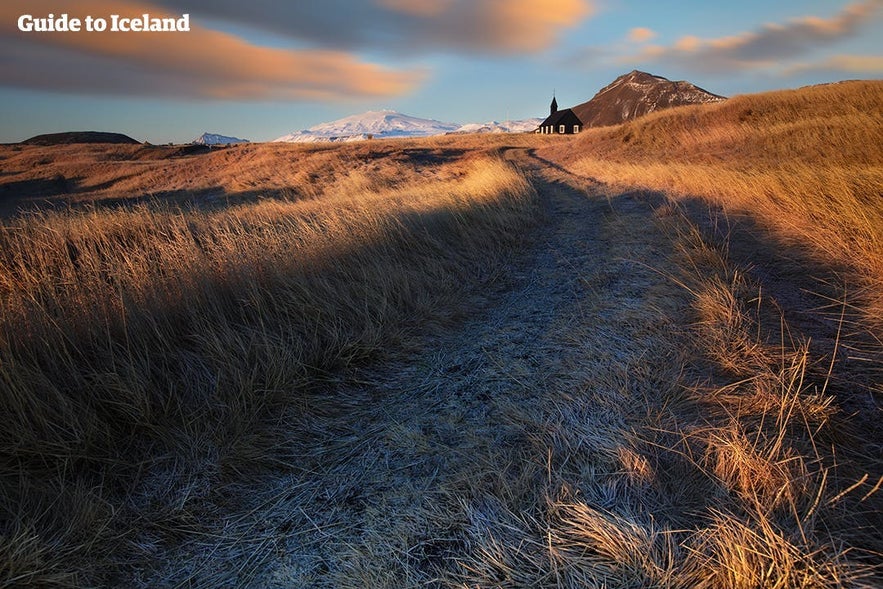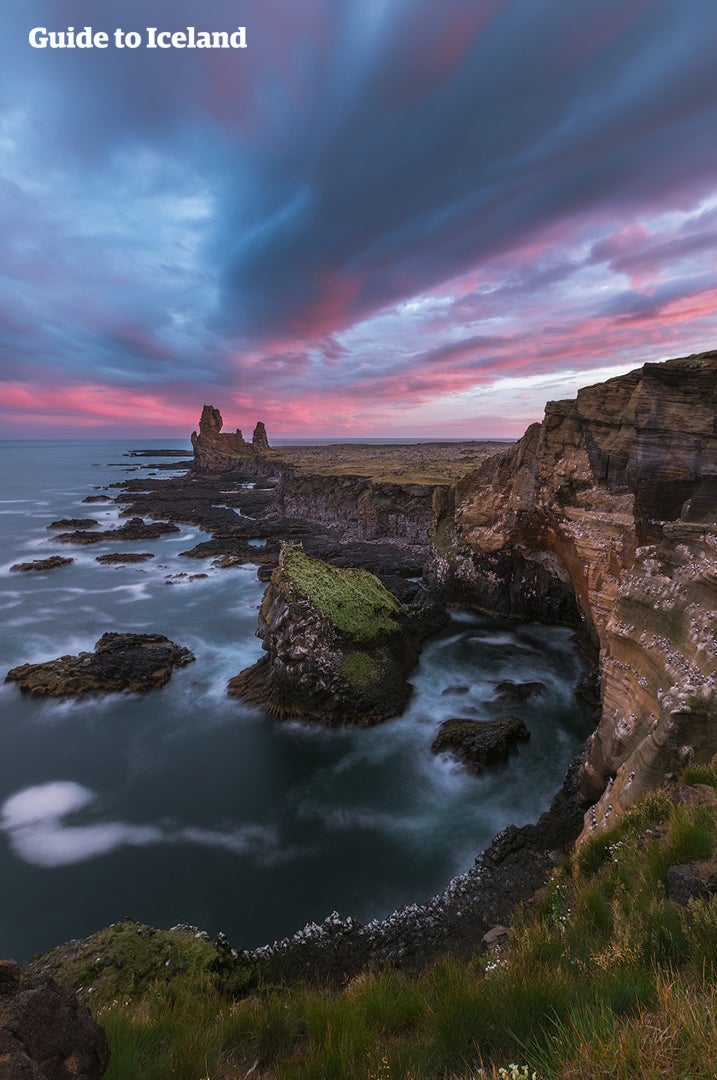
Snæfellsjökull is a glacier-capped volcano found on the tip of the Snæfellsnes Peninsula in west Iceland. It stands in a National Park of the same name, one of the only three National Parks in the country.
Explore this region on a tour of Snaefellsnes. It is, also, the highlight of many tours, such as this one around the peninsula, and visited on countless guided packages and self-drives throughout the year, such as on this 6-Day Winter Vacation. Those who rent a car can take their time encircling it.
Why You Can Trust Our Content
Guide to Iceland is the most trusted travel platform in Iceland, helping millions of visitors each year. All our content is written and reviewed by local experts who are deeply familiar with Iceland. You can count on us for accurate, up-to-date, and trustworthy travel advice.
It stands at 1,446 metres (4,744 feet) tall, and on clear days, is visible across the bay from Reykjavík. The stratovolcano beneath Snæfellsjökull is 700,000-years-old.
The mountain is actually called 'Snæfell' (Snowy Mountain), though the 'jökull' (Glacier) is often added to help distinguish it from other mountains of the same name.
For the first time in recorded history, Snæfellsjökull had no snow or ice at its peak in August 2012, causing concern among locals that climate change is threatening the nature of the mountain.
History
Snæfellsjökull has several small villages surrounding it, including Hellissandur, Rif and Ólafsvík, all of which were some of the busiest commercial and fishing hubs in the country for much of the last millennium.
Fishing took off primarily in the 13th-Century, with fishing stations being built in all areas with easy access to the open ocean. The Snæfellsnes Peninsula was a notable centre of this industry, due to the fertile waters within Breiðafjörður bay.
One notable example would be the settlement of Dritvík; in spite of its minuscule size today, it once utilised around forty to sixty boats and employed up to six hundred people.
Fishing in the region declined during the 19th century due to change in Iceland’s industry and fish stocks, though it is still an important source of livelihood for those living on the Peninsula.
The Snæfellsjökull National Park was established in 2001, and tourism is rapidly changing the trade of the area.
In Folklore
Snæfellsjökull has, for centuries, been considered to be one of the world’s ancient power sites, a source of mysticism, energy and mystery for the peninsula’s superstitious population.
The feature takes a prominent role in Bárðar saga Snæfellsáss, a late 14th-century saga that tells the story of Bárður, half-human-half-troll, who became the 'guardian spirit of Snæfellsjökull'.
There are many rock formations on and around Snæfellsjökull that are said to be trolls petrified by sunlight or else homes of the hidden people.
On November 5th, 1993, thousands of people came to Snæfellsjökull as some paranormal enthusiasts believed there would be an alien landing; CNN even showed up with a camera crew. Though the evening passed without a galactic invasion, the incident shows the strange significance of Snæfellsjökull to many.
In Literature
Snæfellsjökull serves as the entrance to a fantastical subterranean world in Jules Verne’s classic 1864 novel 'Journey to The Centre of The Earth'. Given its central place in the novel, Snæfellsjökull has become one of the most popular spots for visitors in Iceland and has inspired a wealth of writers, poets and artists.
Since 'Journey to The Centre of The Earth', Snæfellsjökull has appeared in the ‘Blind Birds’ trilogy by Czech science fiction writer Ludvík Souček (partially based on Jules’ work) and in ‘Under The Glacier’, a novel by Iceland’s only Nobel laureate, Halldór Laxness.
Nearby Attractions
Along with the glacier, attractions on the Snæfellsnes Peninsula include the two nearby basalt cliffs called Lóndrangar and the many fascinating lava formations at the beautiful Djúpalónssandur beach, such as the arch rock Gatklettur.
At Djúpalónssandur, one can also test their muscle as historic sailors once did with the four 'strength' stones, Amlóði ('Useless'), Hálfdrættingur ('Weakling'), Hálfsterkur ('Half Strength') and Fullsterkur ('Full Strength').
In the area, one can also explore the Saxhóll volcano crater and 'the singing cave' Sönghellir, which is named after the loud echoes inside.










